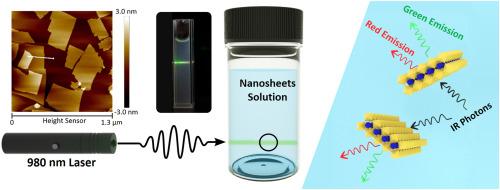Exploring the upconversion tunability of unilamellar [SrTa2O7]2- nanosheets derived from Aurivillius Bi2SrTa2O9
IF 3.6
3区 物理与天体物理
Q2 OPTICS
引用次数: 0
Abstract
This study presents the first report on high-yield and large-sized unilamellar [SrTa2O7]2- nanosheets with upconversion (UC) properties derived from the Aurivillius phase Bi2SrTa2O9. By employing three-step exfoliation process using exfoliating agents with only moderate size differences—large enough to enable exfoliation while preventing excessive strain—we successfully obtained nanosheets with lateral dimensions reaching up to the micron scale. This controlled exfoliation approach minimizes nanosheet fragmentation, allowing the retention of large lateral sizes. One of the key advantages of Aurivillius phase perovskite oxides for UC applications is their relatively low lattice phonon energy, which is comparable to other well-known efficient UC host materials. The nanosheets were synthesized through a solid-state reaction with Er(III), Ho(III), Tm(III), and Yb(III) lanthanide doping, followed by selective acid washing and exfoliation. Structural analysis confirmed the successful incorporation of lanthanides into the perovskite layers, preserving UC behavior in the exfoliated nanosheets. The effect of sensitizer-to-activator ratio on UC emission was systematically investigated, revealing tunable multicolor emission. The nanosheets exhibit comparable emission characteristics to their bulk counterparts, demonstrating their potential for integration into optical applications. These findings highlight the viability of Aurivillius-based nanosheets as functional UC materials with tunable emission properties.

探索单层[SrTa2O7]2-纳米片的上转换可调性
本研究首次报道了由Aurivillius相Bi2SrTa2O9衍生的具有上转换(UC)特性的高产率和大尺寸单层[SrTa2O7]2-纳米片。通过使用尺寸差异适中的去角质剂,采用三步去角质工艺,我们成功地获得了横向尺寸达到微米级的纳米片。这种受控的剥落方法最大限度地减少了纳米片的破碎,允许保留大的横向尺寸。Aurivillius相钙钛矿氧化物用于UC应用的关键优势之一是其相对较低的晶格声子能量,可与其他已知的高效UC宿主材料相媲美。采用Er(III)、Ho(III)、Tm(III)和Yb(III)镧系元素掺杂的固相反应合成纳米片,然后进行选择性酸洗和剥离。结构分析证实了镧系元素成功地结合到钙钛矿层中,在剥离的纳米片中保留了UC行为。系统地研究了敏化活化剂比对UC发射的影响,揭示了可调的多色发射。纳米片表现出与它们的块状对应物相当的发射特性,证明了它们集成到光学应用中的潜力。这些发现强调了基于aurivillius的纳米片作为具有可调发射特性的功能性UC材料的可行性。
本文章由计算机程序翻译,如有差异,请以英文原文为准。
求助全文
约1分钟内获得全文
求助全文
来源期刊

Journal of Luminescence
物理-光学
CiteScore
6.70
自引率
13.90%
发文量
850
审稿时长
3.8 months
期刊介绍:
The purpose of the Journal of Luminescence is to provide a means of communication between scientists in different disciplines who share a common interest in the electronic excited states of molecular, ionic and covalent systems, whether crystalline, amorphous, or liquid.
We invite original papers and reviews on such subjects as: exciton and polariton dynamics, dynamics of localized excited states, energy and charge transport in ordered and disordered systems, radiative and non-radiative recombination, relaxation processes, vibronic interactions in electronic excited states, photochemistry in condensed systems, excited state resonance, double resonance, spin dynamics, selective excitation spectroscopy, hole burning, coherent processes in excited states, (e.g. coherent optical transients, photon echoes, transient gratings), multiphoton processes, optical bistability, photochromism, and new techniques for the study of excited states. This list is not intended to be exhaustive. Papers in the traditional areas of optical spectroscopy (absorption, MCD, luminescence, Raman scattering) are welcome. Papers on applications (phosphors, scintillators, electro- and cathodo-luminescence, radiography, bioimaging, solar energy, energy conversion, etc.) are also welcome if they present results of scientific, rather than only technological interest. However, papers containing purely theoretical results, not related to phenomena in the excited states, as well as papers using luminescence spectroscopy to perform routine analytical chemistry or biochemistry procedures, are outside the scope of the journal. Some exceptions will be possible at the discretion of the editors.
 求助内容:
求助内容: 应助结果提醒方式:
应助结果提醒方式:


